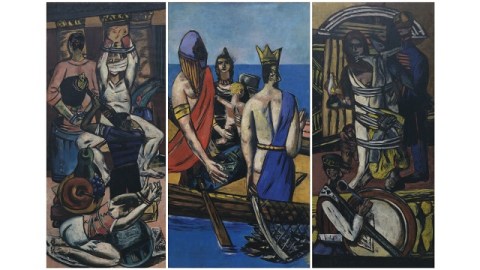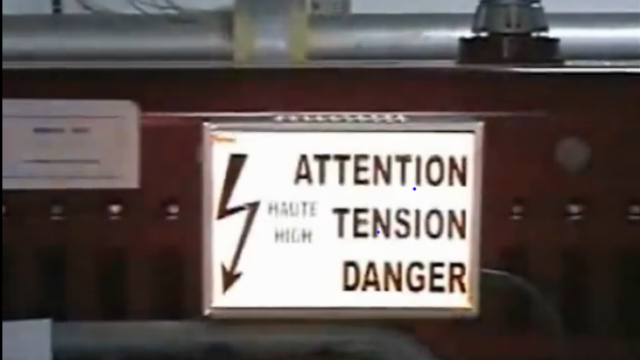The Sad, Strange History of “Degenerate Art”

“Crazy at any price!” read a sign above the modern art masterpieces at the Nazi-sponsored Entartete Kunst (“Degenerate Art,” in English) exhibition in Munich, Germany, in 1937. The fevered brainchild of art-obsessed Adolf Hitler, Entartete Kunst aimed at showing not only what “Jewish” and “Bolshevik” art looked like, but also arguing how the degeneracy of those artists and their work threatened the spiritual health of the German people, the “master race” Hitler believed would rule the world, with him as their leader. The Neue Galerie in New York City revisits that sad moment in modern art history with the exhibition Degenerate Art: The Attack on Modern Art in Nazi Germany, 1937, which runs through June 30, 2014. The exhibition gathers together many of the “crazy” works labeled as degenerate, holds them up against examples of the Hitler-approved German art, and takes us down the long, strange road that led up to that Munich show. The result is a sad, strange history that will leave you shaking your head at the past, but will also make you wonder if it could happen, again, here and now.
World War II is rightly measured in its human toll, especially the unforgettable six million numbered among the dead from the Holocaust. But Hitler’s cultural program to erase all civilization save what he approved of remains a significant aspect of that conflict. A failed artist himself, Hitler wanted to mold the German soul in every way, including how it viewed the world through the prism of art. Thus, art, especially the art of the Jews or those he felt had been supported by the Jews, had to be stopped. Hitler’s ideas for art go all the way back to his 1925 autobiography, Mein Kampf, published 12 years before Entartete Kunst, but Hitler himself got those ideas from a book published by Simcha Südfeld, under the alias of Max Nordau, in 1892 and 1893 titled Entartung(“Degeneration”). Hitler, however, never gives Nordau any credit for one simple reason—Nordau was a Jew.
As Olaf Peters, guest curator of the exhibition from the Martin-Luther-Universität Halle-Wittenberg, points out in his catalogue essay, “From Nordau to Hitler: ‘Degeneration’ and Anti-Modernism Between the Fin-De-Siècle and the National Socialist Takeover of Power,” “[o]ver the course of the nineteenth century, concepts such as decadence and degeneration increasingly found their way into both cultural criticism and scientific discourse” until eventually, “[t]he National Socialists reduced this discourse to racist themes and instrumentalized it as a constitutive component of their propaganda for the policy of extermination created by the ‘Third Reich.’” Nordau, a trained physician, felt that the pace of modernization disturbed the human mind to the point of creating mental illness that he categorized as “degeneration.” Remove the stimuli of modernization, the reasoning followed, and the mind would return to a healthy state, Nordau the wayward Darwinist argued. Yet, even from the beginning, Nordau’s “degenerate” label found itself linked with anti-Semitism, despite his best efforts. “In the process, however,” Peters points out, Nordau “too used the term ‘stigma’ in reference to physical symptoms,” thus setting the stage for others, including the Nazis, to seek tangible proof for their accusations of “degeneracy.”
In another irony, Nordau’s idea of a “degenerate artist” of the late 19th century included composer Richard Wagner and author-philosopher Friedrich Nietzsche, the twin towers of Hitler’s ideal of Germanic art. Hitler and the Nazis took Nordau’s idea, but replaced who were the “degenerates.” They set the year 1910 as the cut-off point for acceptable art, thus catching Fauvism, Expressionism, Cubism, and even war-mad Futurism in their ideological net. “By doing so,” Peters continues, the Nazis “shifted this incriminated field, contrary to Max Nordau, clearly into their own present, while reviving Wagner and Nietzsche, whom Nordau had denounced as ‘degenerate.’” Consistent only in their inconsistency, the Nazis struggled to agree on the list of “degenerates,” with figures such as chief propagandist Joseph Goebbels considering the German Expressionists as a possibly acceptable group, at least until Hitler made his opinion perfectly clear.
As Ines Schlenker points out in her catalogue essay, “Defining National Socialist Art: The First ‘Grosse Deutsche Kunstausstellung’ in 1937,” Hitler vaguely defined acceptable Nazi art as “eternal, stemming from the inner being of a people,” leaving curators and artists scrambling to abide by his unclear wishes. Embarrassingly, thanks to this widespread miscommunication, some artists appeared in both “degenerate” and approved exhibitions. When one selection committee failed to pick the correct art, Hitler tapped his personal photographer Heinrich Hoffmann as curator, but even Hoffmann needed Hitler’s final, personal approval. Artists such as Emil Nolde found themselves initially accepted by the Nazis (especially Goebbels, who decorated his home in Node originals, at least until Hitler dropped by) only to find themselves later examples of “inner emigrates” (versus those emigrates who fled) who not only had their art removed from German collections to be sold or destroyed, but also were forbidden to make new art on pain of death. (Nolde continued to paint in watercolor, fearing that the smell of oil paint would give him away.) Even Hitler-approved artists such as Adolf Ziegler, whose triptych Die vier Elemente(The Four Elements) once hung above Hitler’s fireplace in the Munich Führerbau but now appears in the Neue Galerie show, could find themselves in a career- and life-jeopardizing situation with one wrong move. (Ziegler spent weeks at the concentration camp in Dachau for his “defeatist attitude” before Hitler had him released.)
Entartete Kunst was not the first exhibition of “Degenerate Art.” Schandausstellungen or “exhibitions of shame” popped up in Nazi-sympathizing galleries for years. Just two months after taking control of Germany in 1933, the Nazis staged an exhibition titled Kulturbolschewistische Bilder or “Cultural Bolshevist Images.” Entartete Kunst, however, may have been the biggest and remains the most notorious to this day. Thanks to a short silent film by American filmmaker Julien Bryan (available online here), we know how Entartete Kunst looked, right down to the range of reactions of the German citizens come face to face with modern art by such now-esteemed figures as George Grosz, Ernst Ludwig Kirchner, Paul Klee, Oskar Kokoschka, Marc Chagall, and Vasily Kandinsky, all of whom are represented among the approximately 50 paintings and sculptures, 30 works on paper, and posters in the Neue Galerie’s small-scale recreation.
In addition to photographs and memorabilia from the 1937 exhibition, a separate room in the Neue Galerie will hold pieces from the Grosse Deutsche Kunstausstellung (or “Great German Art Exhibition”), the counter-exhibition showing the “healthy” German art so close to Hitler’s own black heart. Sadly, we have only photographs but no film footage of that counter-exhibition, but one can only imagine the expressions of people walking among the cheesy portraits of Hitler (a dozen in all) as well as Aryanized classical nudes and idealized peasant workers. The Nazis stacked the aesthetic deck against the “Degenerate Art” by removing the pictures from their frames, hanging them as unflatteringly as possible, and adding the chaos of oversized wall text in bizarre fonts to create the impression of madness. In hopes of angering tax-conscious citizens, “degenerate” works in German national museums came tagged with the price the German people paid (but never pointing out that the largest prices came during the inflationary times of the late 1920s, when people pushed wheelbarrows full of marks around to buy a loaf of bread). In contrast to the organized madness of Entartete Kunst, the show of “great” German art epitomized rationality and order to the dullest degree.
If you compare Max Beckmann’s “degenerate” Departure (shown above) to Adolf Ziegler’s Hitler-approved Die vier Elemente, you can see the world of difference between the two artists and their approaches. Beckmann, who fled the Nazis, painted his aesthetic and spiritual departure from his homeland in a clearly Expressionist manner using the whole arsenal of modern techniques. Ziegler, however, paints textbook academic female nudes and slaps elemental labels on them—all the trappings of classical art with none of the classical technique. In her analysis of the reasons why Hitler-approved art was so bad, Schlenker quotes Hitler’s photographer-turned-curator Hoffmann’s lament that “Unfortunately […] no genius like [Adolph] Menzel, [Friedrich] Kaulbach, [Moritz von] Schwind and so on emerges from the contemporary painters in spite of all the sponsorship.” By trying to turn back the clock to the 19th century, Hitler wanted art to return to a time and style that no longer resonated with modern artists or audiences. But no amount of money or threats could change the fact that all the top tier artists embraced modernism, leaving only the second stringers to put Hitler’s ideals into artistic action.
Beckmann’s Departure holds significance not only for German art history, but also for American art history. In “From Lucerne to Washington, DC: ‘Degenerate Art’ and the Question of Restitution,” Jonathan Petropoulos spotlights the actions of MoMA founder Alfred Barr, who obtained many works for the collection that previously belonged to German museums, sometimes to the profit of the Nazi regime. Departure entered the MoMA collection as a “gift” that was also partly an exchange, blurring the lines between legality and morality. “I frankly thought it was a good thing for the Germans as a whole to have some reminder of their collective guilt and folly,” Barr later rationalized. “Barr, it seems, utilized the notion of German guilt for the crimes of the Nazi regime as a means of resolving and rationalizing the troubling moral issues,” Petropoulos concludes. In Barr’s mind, the Germans didn’t deserve the modern masterpieces they once rejected, or at least didn’t deserve them as much as the appreciative MoMA did. In yet another irony, as Ruth Heftrig points out in her catalogue essay, “Paradoxically, the stigmatization of modernism caused by the National Socialists is partly responsible for the current boom in modern art.” Post-war Germans and German museums overcorrected the evils of the “Degenerate Art” age by embracing and promoting modern art more than any other country. Fighting for modern art suddenly became a way of fighting against the Nazi legacy. Thus, contra Barr, Germany today might “deserve” modern art more than anyone.
American audiences can look back at Entartete Kunst through exhibitions such as Degenerate Art: The Attack on Modern Art in Nazi Germany, 1937 with a sense of detachment, a feeling of clean hands despite questions about how the MoMA and other American museums benefitted from Nazi art policy. But the larger issue that lingers is whether we still see any kind of art as “degenerate” or “unhealthy” to the point of censure. As recently as 2010, the exhibition Hide/Seek: Difference and Desire in American Portraiture met with opposition over David Wojnarowicz’s 1987 video “A Fire in My Belly” because of the combination of its religious content and his sexual orientation. The “Culture Wars” waged in the 1990s seem now part of the distant past, but the Hide/Seek controversy proved that ideas of “degenerate art” in America persist, with sexual orientation replacing religion and race as the target. If Degenerate Art: The Attack on Modern Art in Nazi Germany, 1937 holds a warning from history, it’s that any time we set some group or its means of expression apart with labels, those labels say less about them and more about us.
[Image:Max Beckmann (1884-1950). Departure, Frankfurt 1932, Berlin 1933-35. Oil on canvas. 84 ¾ x 39 ¼ in. (215.3 x 99.7 cm). The Museum of Modern Art, New York. Given anonymously (by exchange). Digital Image © 2014 The Museum of Modern Art/Licensed by SCALA/ Art Resource, NY. © 2014 Artists Rights Society (ARS), New York/VG Bild-Kunst, Bonn.]
[Many thanks to the Neue Galerie in New York City for providing me with the image above from, a review copy of the catalogue to, and other press materials related to the exhibition Degenerate Art: The Attack on Modern Art in Nazi Germany, 1937, which runs through June 30, 2014.]





